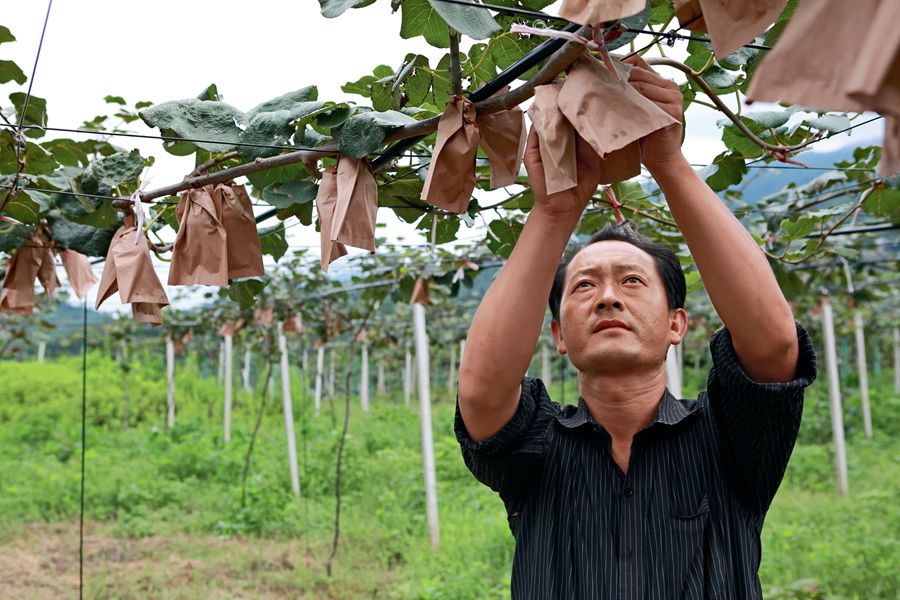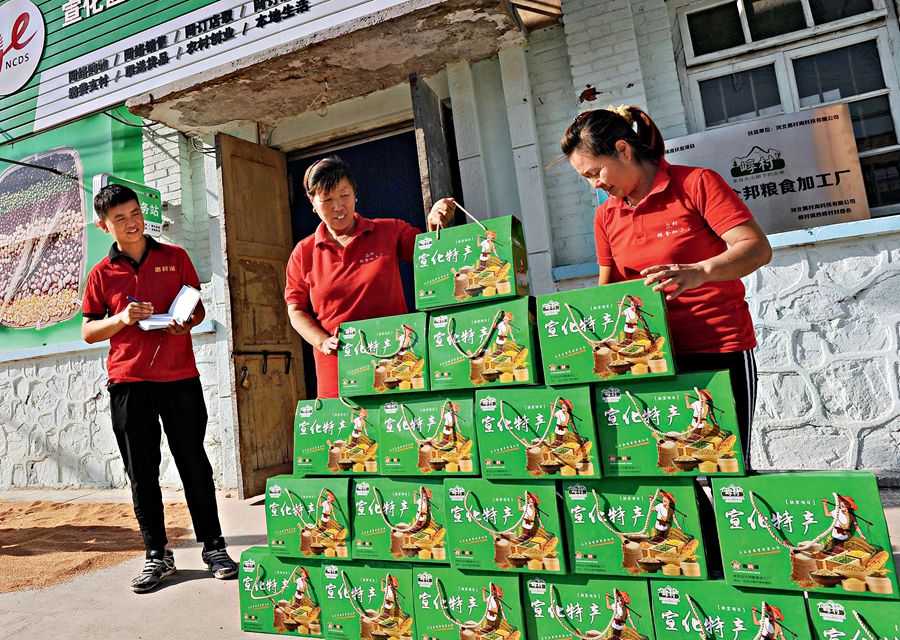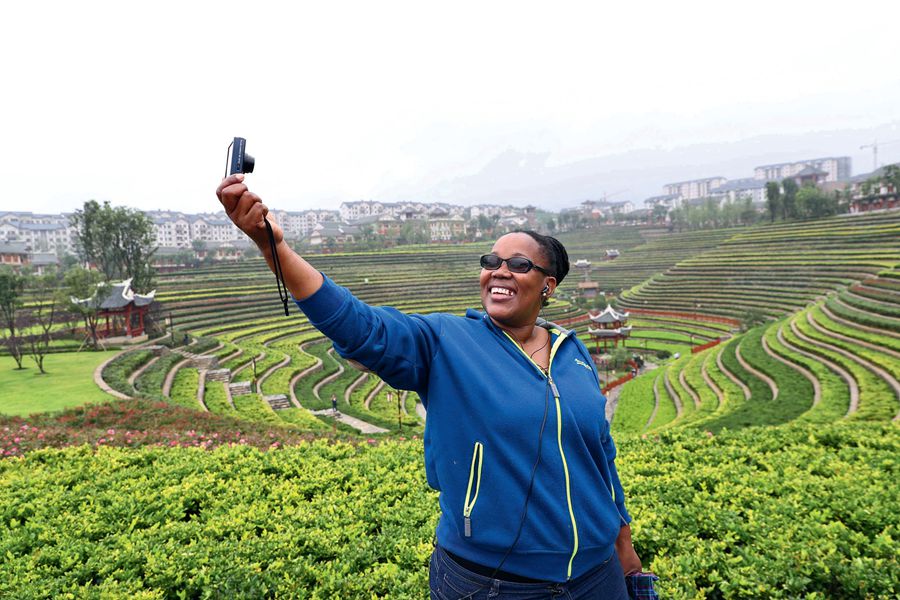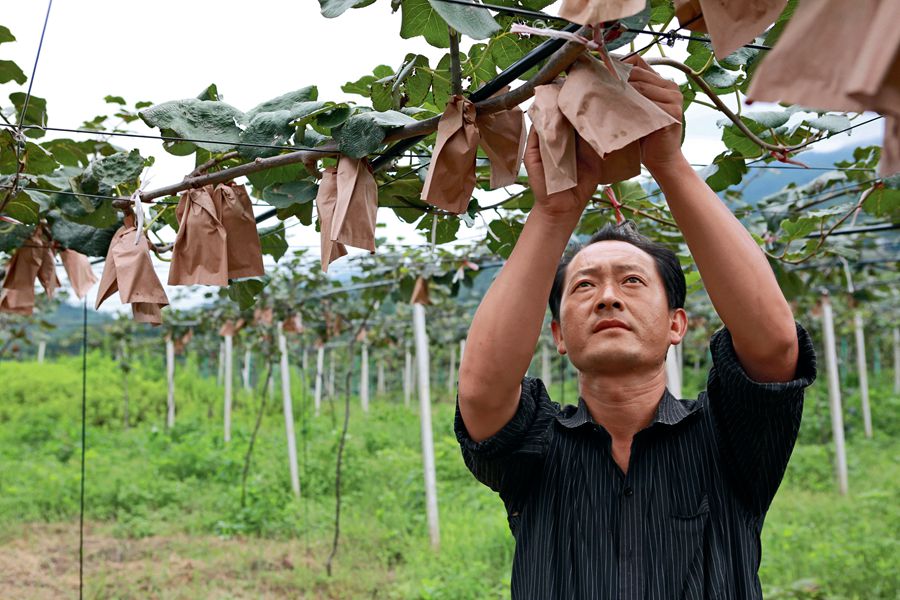GREEN poverty alleviation is an approach to achieving both economic prosperity and ecological conservation by carrying out targeted measures for eradicating poverty. The guidelines and practices of green development run through the entire poverty relief campaign in the quest to improve the wellbeing of the poor in a sustainable way.
From vision to practice, green poverty alleviation is becoming an integral part of China’s efforts to fight poverty.
Keeping a Balance
In some poor regions of China where the ecosystem is fragile, local people are working out new ways to better use the resources they have to improve their lives. These include the land, labor forces, waterways, and mountainous landscapes. Green poverty alleviation is a way to increase incomes by turning the resources to assets, capital to shares, and farmers to shareholders.

A farmer in Liupanshui, Guizhou Province, rises above poverty by growing kiwi fruits.
The best scenario is to pursue both economic development and protect the environment in poverty-stricken areas. The key to this is development. The economic miracle China has achieved over the past four decades has shown that development is the foundation from which people can rise above the poverty line.
When the two goals cannot be achieved at the same time, environmental conservation prevails over economic development. This means that poor areas should stop pursuing temporary growth at the expense of the environment. More attention should go to ecological conservation when boosting the local economy.
When it comes to turning the clean water and lush mountains into invaluable assets, the key is to devise an inclusive plan to build a community where human beings live in harmony with nature. This is the overarching guideline for development in poverty-stricken areas.
Green Prosperity
Lifting people out of poverty through green development is a decision made based on the reality that poor people living in a fragile ecosystem always have to choose between economic growth and environmental conservation. Among the county-level areas where the ecology is vulnerable, 76 percent are stricken by poverty and included in the national program for poverty alleviation and development. The land area, arable land, and population of these poor but environmentally-disadvantaged counties account for 43 percent, 68 percent, and 76 percent of the total numbers of all Chinese counties respectively.
In November 2015, the Central Committee of the Communist Party of China (CPC) and the State Council adopted a pivotal decision that charts the course for the country’s poverty alleviation campaign through to 2020. It calls for the implementation of the vision of innovative, coordinated, green, and open development in poverty reduction efforts.

The grain processing plant of Xiguo Village, Zhangjiakou City of Hebei Province.
The United Nations Environment Programme has been advocating green economy initiatives since 2008 and made it a global concern. The Organization for Economic Cooperation and Development began to introduce green growth strategies in the same year. A green economy against the backdrop of sustainable development and poverty eradication was adopted as one of the themes in the United Nations Conference on Sustainable Development in 2012, which was held in Rio de Janeiro, Brazil. In 2015, 193 UN member states unanimously approved the 2030 Agenda for Sustainable Development.
China’s commitment to eradicating poverty through green development is a robust response to the agenda the UN has been advocating, showing that China has been proactively assuming its responsibility as a big country. From this perspective, all activities to develop poverty-stricken areas and improve the livelihoods of the impoverished should follow the guiding principle of green development.
The local government of Baihuahu Town, Guanshanhu District, Guiyang, capital city of southwest China’s Guizhou Province, has explored a successful path for both economic development and environmental conservation. Its practice mirrors the efforts China has made in green poverty alleviation.
A landlocked mountainous province, Guizhou is one of the poorest regions in China. The core of what Baihuahu Town has done is to strike a balance between economic growth and environmental protection. The local government gives full play to the region’s distinctive natural resources and landscapes to foster agro-tourism, and tea and spring-water-related businesses. This path to becoming prosperous based on local conditions has proved to be successful.
Measures to Adopt
President Xi Jinping pointed out that China should speed up reform of the system for promoting ecological progress, and build a beautiful China. To this end, he set out four goals – promoting green development, solving prominent environmental problems, intensifying the protection of ecosystems, and reforming the environmental regulation system.

A participant of the 2018 FOCAC-Africa-China Poverty Reduction and Development Conference visits Bijie of Guizhou Province on August 16, 2018 to learn from its poverty alleviation experience.
To accelerate development in poverty-stricken areas, the first step should be securing a victory in the pitched battle against poverty. The key to fulfilling the poverty eradication goals on schedule, and lifting all poor counties and people out of poverty is to put the vision of green development into action and to make gains in poverty eradication through green development using effective measures.
First, new development visions should guide the entire poverty reduction campaign. To make headway in poverty alleviation while promoting ecological progress, local governments should implement new development visions, respect environmental regulations and show determination toward restructuring the economy. Resource-efficient development should be promoted for sustainable growth. While valuing environmental protection, emphasis should be placed on the improvement of people’s livelihoods. The ecological compensation system should also be enhanced.
Second, more supportive policies should go to green businesses in line with the supply-side structural reform. The promotion of ecological progress in poverty-stricken areas is closely related with the supply-side structural reform. With green development as the focus and a modern industrial system as the goal, local governments in poor areas should encourage green businesses. When upgrading labor-intensive manufacturing industries, they should apply new technologies to improve the efficiency of energy consumption and lower emissions.
Local governments should promote the Internet Plus initiative in fostering green businesses for poverty alleviation so as to help the economy to shift gears. They should also give full play to the valuable assets of fresh water, mountains and clean air for potential emerging strategic industries, while keeping tourism development in tune with ecological preservation. Agro-tourism and e-commerce are recommended development models in promoting green economy in rural areas.
When implementing specific projects, local governments should ensure that the boundary for urbanization and the bottom lines for ecological security and farmland protection remain untouchable. The location, scale, and business sector of the projects should be well planned, with a strict approval system introduced to contain pollutant emissions and energy consumption from the source.
Third, a green lifestyle should be advocated. When fighting poverty in impoverished areas, local governments should also raise public awareness on environmental preservation and a green lifestyle so that these visions could guide people’s behavior in daily life. To this end, local governments could support eco-cultural products and brands. They could incorporate the awareness on ecological progress and poverty alleviation through green development into public education and the evaluation system for officials. The green lifestyle should also be advocated in rural areas. In addition, public participation and supervision systems need improvement in this regard. This could be done by encouraging non-governmental organizations and volunteers to launch campaigns in communities and on primary levels.
HUANG CHENGWEI is director of the national publicity and education center for poverty alleviation under the State Council Leading Group Office of Poverty Alleviation and Development.




